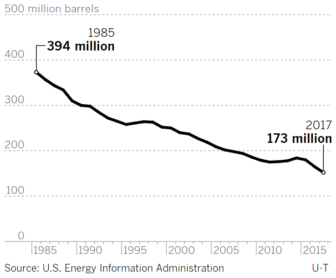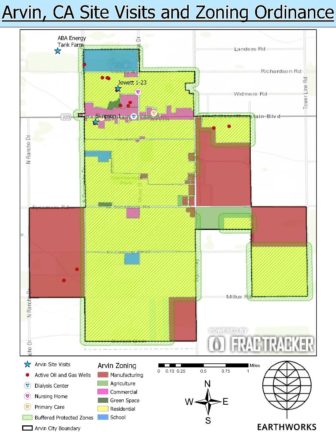On July 17, 2018, the City of Arvin, CA passed a setback ordinance restricting new oil and gas wells from within 300 feet of residential and commercially zoned areas.
In a state such as California, local ordinances restricting the oil and gas industry are no small feat. In fact, this is the first local setback policy in a California county that is actively producing oil and gas. This accomplishment is thanks to the strength and tireless work of community and grassroots groups, especially the Central California Environmental Justice Network and The Center on Race, Poverty and the Environment.
In support of their efforts, Earthworks’ California team filmed methane and volatile organic compound (VOC) pollution at the city’s existing well sites using optical gas imaging (OGI) technology.
Oil rights pre-date civil rights.
California is the golden state. For many, oil is black gold. For extraction companies like Chevron, Exxon, Valero and California Resources Corporation, the development of California oil fields was an industrial gold rush for most of the 20th century.

In the process these companies secured the corporate oil lobby as an appendage to every level of California government, a state of affairs which continues to this day. That’s why movements such as the “Oil Money Out” campaign have been pressuring the California legislature to remove oil money from politics, even as the industry spent over $122 million lobbying in California over just the last six years. In such a political climate community health and environmental stewardship are consistently on the defense.
Arvin, CA is on the frontlines of that defense. The city is located just south of Bakersfield in California’s Central Valley–ground-zero for oil and gas extraction. Not only is California one of the top oil producing states in the country, Kern County, in the heart of the Central Valley, is the highest producing county in the United States.
This is particularly important considering the county’s oil fields – Kern River, South Belridge, Lost Hills – have been producing for over 100 years. This is a century longer than high-producing unconventional fields in other parts of the United States, such as the Permian and Bakken. This remains true even as production has been decreasing in California since hitting its peak in 1985 (see figure 1).
Arvin, CA’s New Setback and Zoning Ordinance

Now, the City of Arvin, CA has passed a bold measure to protect the community from urban oil and gas development. The ordinance prevents wells from being drilled in residential or commercially zoned spaces. Setback distances of 300 feet for new development and 600 feet for new drilling operations have also been established for sensitive sites, such as parks, hospitals, and schools. More details and maps of the setback ordinance and its development can be found in the FracTracker Alliance’s coverage of the proposal, here.
Unfortunately, the ordinance doesn’t address existing urban oil and gas wells, including those producing pollution documented by Earthworks. Tackling the issue of how to address existing wells and forcing operators to eliminate fugitive emissions will require additional work. Making sure that air districts implement the new California greenhouse gas rules may help.
Optical Gas Imaging of pollution
In collaboration with Central California Environmental Justice Network, and in support of the setback ordinance, Earthworks filmed multiple well sites just prior to the Arvin city council’s vote. Using OGI technology (a FLIR GF320 camera), Earthworks documented otherwise invisible major pollution events at three well sites within the city limits. The locations of the well and infrastructure sites are labeled in the map above (Figure 2).
In this FLIR video, fugitive emissions are obviously coming from the pressure vacuum (PV) vent at the top of the produced water tank. Based on permits and other information, the emissions are clearly a mixture of a variety of VOCs and methane. This well site is located between homes, a small apartment complex, and a playground.
While on the ground operating the FLIR camera, I felt light headed, dizzy, and developed a headache. I reported the emissions and filed a formal complaint with the San Joaquin Valley Air Pollution Control District (SJVAPCD), which conducted its own investigation and found VOC concentrations at dangerous levels. The well operator was notified but refused to respond.
Unfortunately, because this particular well produces under 50 barrels of oil/day, the site is exempt from district regulations on the storage of liquids in tanks. But SJVAPCD did find that the Simpson well was emitting a high enough volume of gases to subject it to regulation under the California greenhouse gas rules—a regulatory finding we will continue to push.
The Jewett well site is located near a number of single family homes and next to a park. The well site is also on the future location of the Arvin Community College. This OGI video shows fugitive emissions from four different locations, including a leak at the well head that is potentially underground, another on separator equipment, and emissions from each of the tank PV hatches.
After I notified regulators, they visited the site and the operator had to fix two of the leaks immediately. Fugitive emissions from the PV hatches were not addressed because this site is also exempt from district regulations on the storage of liquids in tanks. In not addressing those emissions, the operator inadvertently makes the case for getting ironclad air pollution protections in place.
ABA Energy Corporation Richards Facility Tank Farm
The Richards Facility Tank Farm is located outside the city limits on farmland. Because the facility is regulated as a point source of air pollution, enforcement action can require the operator to fix leaks even from PV hatches on tanks. The OGI video shows methane pollution from PV hatches, and a major leak from a broken regulator valve. I submitted a complaint to the SJVAPCD, which then required the operator to replace the broken valve.
My recent field experience as a thermographer for Earthworks demonstrates the value in documenting emissions and holding regulators accountable for reducing oil and gas pollution. Just as the residents of Arvin have done for years, we too have an obligation to speak out—and when we all do collectively, change can clearly happen.
Kyle Ferrar works with FracTracker Alliance to conduct and communicate research on the public health impacts associated with the oil and gas / fossil fuel industry.

